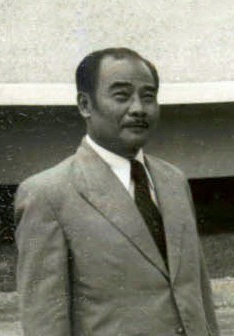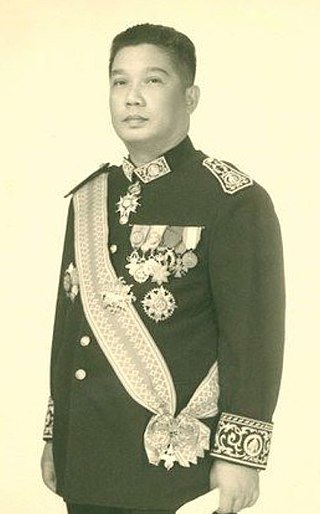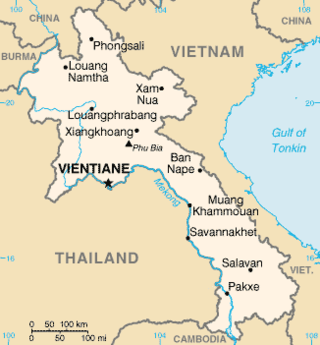Related Research Articles

Laos, officially the Lao People's Democratic Republic, is the only landlocked country in Southeast Asia. At the heart of the Indochinese Peninsula, Laos is bordered by Myanmar and China to the northwest, Vietnam to the east, Cambodia to the southeast, and Thailand to the west and southwest. Its capital and largest city is Vientiane.

Prince Souphanouvong, nicknamed the Red Prince, was along with his half-brother Prince Souvanna Phouma and Prince Boun Oum of Champasak, one of the "Three Princes" who represented respectively the communist (pro-Vietnam), neutralist and royalist political factions in Laos. He was the President of Laos from December 1975 to October 1986.

The Three Princes was a name given to Princes Boun Oum, Souvanna Phouma and Souphanouvong who represented respectively the royalist, neutralist and communist factions in the Kingdom of Laos in the post-WWII period, especially during Laotian Civil War. The trio were named by King Sisavang Vatthana to form a coalition government following the independence of Laos.

Air America was an American passenger and cargo airline established in 1946 and covertly owned and operated by the Central Intelligence Agency (CIA) from 1950 to 1976. It supplied and supported covert operations in Southeast Asia during the Vietnam War, including providing support for drug smuggling in Laos.
Laotian Americans are Americans who trace their ancestry to Laos. Laotian Americans are included in the larger category of Asian Americans. The major immigrant generation were generally refugees who escaped Laos during the warfare and disruption of the 1970s, and entered refugee camps in Thailand across the Mekong River. They emigrated to the United States during the late 1970s and throughout the 1980s.

The Akha are an ethnic group who live in small villages at higher elevations in the mountains of Thailand, Myanmar, Laos and Yunnan Province in China. They made their way from China into Southeast Asia during the early 20th century. Civil war in Burma and Laos resulted in an increased flow of Akha immigrants and there are now 80,000 people living in Thailand's northern provinces of Chiang Rai and Chiang Mai.

The United States Central Intelligence Agency (CIA) has been accused of involvement in the trafficking of illicit drugs. Books and journalistic investigations on the subject that have received general notice include works by the historian Alfred McCoy, professor and diplomat Peter Dale Scott, journalists Gary Webb and Alexander Cockburn, and writer Larry Collins. These claims have led to investigations by the United States government, including hearings and reports by the United States House of Representatives, Senate, Department of Justice, and the CIA's Inspector General. The various investigations have generally not led to clear conclusions that the CIA itself has directly conducted drug trafficking operations, although there may have been instances of indirect complicity in the activities of others.

Touby Lyfoung was a Hmong political and military leader. Born in 1919 in Nong Het, Laos, he became the first Hmong politician to achieve national prominence. During his long career, which began under French colonial rule and extended to the communist takeover in 1975, he supported the Royal Lao Government (RLG) and American involvement in the Secret War.

Relations between Laos and the United States officially began when the United States opened a legation in Laos in 1950, when Laos was a semi-autonomous state within French Indochina. These relations were maintained after Laos' independence in October 1953.

Phoui Sananikone locally known as Phagna Houakhong was a politician and served as Prime Minister of the Kingdom of Laos from 1950 to 1951 and 1958 to 1959. Since entering government service he had held virtually every top position in the Lao cabinet. The majority of his work as politician concerned the independence and sovereignty of Laos in Southeast Asia, especially in regards of the western-oriented neutrality policy during the height of the Indochina Wars.
The Committee for the Defence of National Interests was an anti-communist right-wing political party founded in the Kingdom of Laos on 17 June 1958. Dismayed by the election of Lao communists to the National Assembly in the May 1958 elections, younger politicians and military officers founded CDNI as an alternative to older Lao politicians and senior officers then in power. The CDNI pronounced itself as a force for anti-corruption efforts in the Royal Lao Government. It was backed by the United States embassy; American support was manifested in political advice and civic actions such as Operation Booster Shot. In the 24 April 1960 elections, which were obviously rigged, the CDNI won 32 of 59 seats. The Pathet Lao leadership had been detained during the election; on 23 May 1960, they escaped to join their insurrection in the mountains. This ended the governing coalition, and fighting began in the Laotian Civil War.

Muang Sing is a small town and district (muang) in Luang Namtha Province, northwestern Laos, about 60 kilometres northwest of the town of Luang Namtha and 360 kilometres northwest of Vientiane. It lies very close to the border with Yunnan, China, surrounded by mountains and rivers. Historically, Muang Sing has been a major producer of opium and still has problems with drugs and smuggling, due to its proximity to China and Myanmar.

The Royal Lao Armed Forces, best known by its French acronym FAR, were the official armed defense forces of the Kingdom of Laos, a state that existed from 1949 to 1975 in what is now the Lao People's Democratic Republic. First created under the French protectorate of Laos on July 1, 1949, the FAR was responsible for the defense of the Kingdom since its independence in October 1953 from France, until its dissolution on December 2, 1975. It operated notably during the North Vietnamese invasion of Laos and the Laotian Civil War from 1960 to 1975.
William Young was a Central Intelligence Agency paramilitary officer born in Berkeley, California and raised in Burma and Thailand. Although he was Caucasian, he was reared in the local hill tribe culture. Because his father and brother already worked for the CIA and knew Bill Lair, the Agency knew of his extensive cultural contacts with the Lahu people and other Southeast Asian hill tribes. With command of several Asian languages, he was made a natural recruiter of local guerrillas for the CIA's covert operations in the secret war in the Kingdom of Laos. He was then considered for the position of case officer to the Hmong Vang Pao. He was passed over in favor of sending him on an extended reconnaissance of the Kingdom of Laos. His tour ranged westward from his start at Long Tieng, which he reported as well sited for operations in the Plain of Jars, back to familiar territory in the Golden Triangle.

The communist insurgency in Thailand was a guerrilla war lasting from 1965 until 1983, fought mainly between the Communist Party of Thailand (CPT) and the government of Thailand. The war began to wind down in 1980 following the declaration of an amnesty, and in 1983, the CPT abandoned the insurgency entirely, ending the conflict.

The 1967 Opium War took place in northwestern Laos between February and August 1967; actual fighting took place from 29 July to 1 August 1967. A mule train, led by Burmese militia, carrying 16 tons of opium crossed into Laos to Ban Khwan, where they were attacked by rival drug smugglers from the Chinese Nationalists' Third and Fifth Armies. The intended recipient of the shipment, Royal Lao Army General Ouane Rattikone, bombed both sides while moving in troops to sweep the battlefield. With both Burmese militia and Nationalist Chinese defeated and expelled from Laos, the Lao general confiscated the opium for himself.
The 1966 Laotian coup d'état was brought about by political infighting concerning control of the Royal Lao Air Force, and use of its transports for smuggling. General Thao Ma, who wished to reserve the transports for strictly military use, was forced into exile on 22 October 1966 by fellow generals angling to use the transports for smuggling opium and gold.

Kou Voravong was a Laotian politician. He was part of the anti-Japanese resistance leading group during the Second World War and then anti-Lao Issara (ລາວອິດສລະ) in the post-war period. Throughout his career, from 1941 to 1954, he has been District Chief, Province Governor, member of the Lao National Assembly, and Royal Lao Government Minister.

Ban Phou Pheung Noi is a Laotian village located at the peak of Phou Pheung mountain in the Xieng Khouang province of Laos. Phou Pheung mountain is approximately 916 m (3,005 ft). During the Vietnam War, combat between the American allies, the Hmong, and the Pathet Lao, The Laos Marxist government, and the Communist North Vietnamese People's Army took place on the mountain. Phou Pheung mountain runs from east to west and is rocky, and is covered in tropical forests. It is south of Muang Soui - Nongtang-Nato, and west of Phou Douk, Muang Phuan, Phonsavan and Plain of Jars. To the east, about 10 miles from Ban Phou Pheung Noi, is the Num Ngum 4 hydroelectric dam.
Major general Oudone Sananikone, or Ûdon Xananikôn, was a Laotian senior officer of the Airborne Forces and the Special Forces of the Royal Lao Army, the land component of the Royal Lao Armed Forces, the official military of the Kingdom of Laos during the 1950s, 1960s and 1970s.
References
- ↑ "Document 192 - Foreign Relations of the United States, 1964–1968, Volume XXVIII, Laos - Historical Documents - Office of the Historian". History.state.gov. Retrieved 2014-05-23.
- ↑ "[CTRL] The CIA and the New Opium War - from Ramparts (May 1971)". Mail-archive.com. 2000-01-04. Retrieved 2014-05-23.